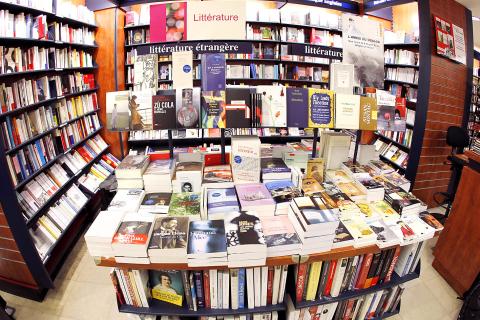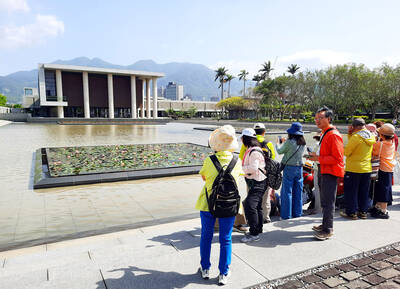All across the US, booksellers have a Christmas wish: that the e-book thrill is gone.
There is reason to believe it will come true. E-book sales have flattened in 2013, giving publishers and bookstores hope that consumers’ appetite for print books will be renewed during the most crucial sales period of the year.
But there are plenty of reasons for holiday anxiety, too, starting with a compressed shopping season, the result of Thanksgiving falling later than it has in a decade. Booksellers also have to contend with the absence of a blockbuster title to drive sales and fill stores, the way the Steve Jobs biography did two years ago. And they must compete with steep discounts on print books from Amazon. It is a grab bag of factors, any one of which could tilt the fortunes of retailers as the holiday book-buying season enters its final days.

Photo: AFP
This is the time when publishers release their splashiest books and count on Christmas shoppers being much more willing to part with US$25 (NT$742) for a weighty hardcover. The leveling off of e-book sales should help. The Association of American Publishers, which collects monthly data from about 1,200 publishers, said last month that e-book sales had been flat or in decline for most of 2013. In August, e-book sales were approximately US$128 million, a 3 percent decline from August 2012.
“I don’t know if it’s a saturation point with digital,” Len Vlahos, the executive director of the Book Industry Study Group, said in a recent interview. “But all the data we see suggests that we’ve hit a state of equilibrium. The trend lines have flattened out. Three years ago, it was a nascent market, but now it looks like a maturing market.”
Jennifer Enderlin, the publisher of St. Martin’s Press Paperbacks and Griffin, said that she thought e-book sales were finding their level, and that it would “start affecting print books in a good way.”
“Independents seem to be having a good run right now,” she said of the bookstores. “They’re having a nice renaissance.”
At Rainy Day Books in Fairway, Kansas, sales are up 10 percent over the previous year, said Vivien Jennings, the owner. McNally Jackson Books, a bustling store in the Nolita neighborhood of Manhattan, has shown “consistent” growth year over year, Sarah McNally, its owner, said.
But bookstore owners and publishers said they were nervous about the short shopping season.
“I think it’s caught people by surprise that it’s less than two weeks from Christmas and Thanksgiving feels like it just happened,” Cathy Langer, the lead book buyer at the Tattered Cover in Denver, said Thursday. “So I’m expecting the next two weeks to be insane.”
Independents have also been forced to compete as Amazon recently slashed prices on some best-selling print books by 70 percent, an extreme discount even by Amazon’s standards. Concern in the publishing industry over the health of Barnes & Noble, the nation’s largest bookstore chain, has only deepened in recent months.
Barnes & Noble has been limping through 2013, abruptly losing its chief executive in July and seeing its chairman, Leonard Riggio, abandon his plan to buy the company’s bookstores and take them private.
Last week, Riggio slightly cut his stake in Barnes & Noble, selling 2 million shares and taking a loss of about US$40 million, a move that he said he made for tax purposes. In November, the company revealed that its revenue had decreased 8 percent, to US$1.7 billion, in the quarter that ended Oct. 26.
A spokeswoman for Barnes & Noble said the company would not release sales data from Thanksgiving weekend.
Publishing executives have wondered in recent months if demand for e-reading devices was also slowing. At a recent internal sales meeting at a major publisher, a high-ranking sales executive flatly told the room: “Anyone who wants to read on a device has gotten their device already.”
Barnes & Noble did not release a new color tablet this year, but did offer an updated Nook GlowLight e-reader.
Analysts said comparing book sales in 2013 to those in 2012 was bound to be disappointing. The popularity of the Fifty Shades of Grey and Hunger Games trilogies buoyed business in 2012, particularly in digital sales.

When the South Vietnamese capital of Saigon fell to the North Vietnamese forces 50 years ago this week, it prompted a mass exodus of some 2 million people — hundreds of thousands fleeing perilously on small boats across open water to escape the communist regime. Many ultimately settled in Southern California’s Orange County in an area now known as “Little Saigon,” not far from Marine Corps Base Camp Pendleton, where the first refugees were airlifted upon reaching the US. The diaspora now also has significant populations in Virginia, Texas and Washington state, as well as in countries including France and Australia.

On April 17, Chinese Nationalist Party (KMT) Chairman Eric Chu (朱立倫) launched a bold campaign to revive and revitalize the KMT base by calling for an impromptu rally at the Taipei prosecutor’s offices to protest recent arrests of KMT recall campaigners over allegations of forgery and fraud involving signatures of dead voters. The protest had no time to apply for permits and was illegal, but that played into the sense of opposition grievance at alleged weaponization of the judiciary by the Democratic Progressive Party (DPP) to “annihilate” the opposition parties. Blamed for faltering recall campaigns and faced with a KMT chair

Article 2 of the Additional Articles of the Constitution of the Republic of China (中華民國憲法增修條文) stipulates that upon a vote of no confidence in the premier, the president can dissolve the legislature within 10 days. If the legislature is dissolved, a new legislative election must be held within 60 days, and the legislators’ terms will then be reckoned from that election. Two weeks ago Taipei Mayor Chiang Wan-an (蔣萬安) of the Chinese Nationalist Party (KMT) proposed that the legislature hold a vote of no confidence in the premier and dare the president to dissolve the legislature. The legislature is currently controlled

Dull functional structures dominate Taiwan’s cityscapes. But that’s slowly changing, thanks to talented architects and patrons with deep pockets. Since the start of the 21st century, the country has gained several alluring landmark buildings, including the two described below. NUNG CHAN MONASTERY Dharma Drum Mountain (法鼓山, DDM) is one of Taiwan’s most prominent religious organizations. Under the leadership of Buddhist Master Sheng Yen (聖嚴), who died in 2009, it developed into an international Buddhist foundation active in the spiritual, cultural and educational spheres. Since 2005, DDM’s principal base has been its sprawling hillside complex in New Taipei City’s Jinshan District (金山). But